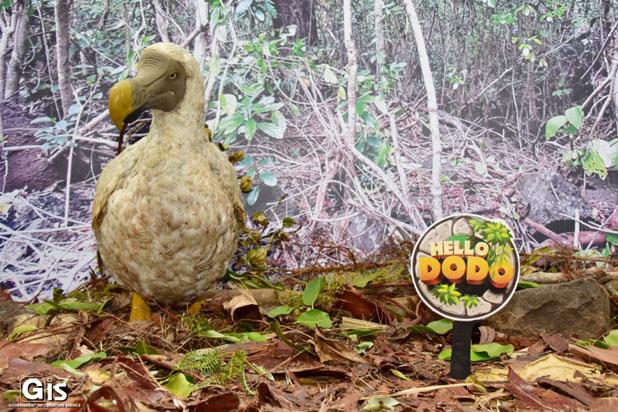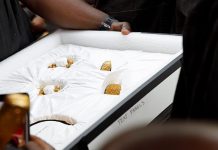
Africa-Press – Mauritius. The Natural History Museum, which is the oldest museum in Mauritius, has entered the digital age by developing the Dodo Augmented Reality (AR) Experience, using the latest augmented reality technologies.
This statement was made by the Prime Minister, Mr Pravind Kumar Jugnauth, this evening, at the National History Museum, in Port Louis. He was speaking in the context of the launching of the website of the National Art Gallery (NAG), together with a virtual rendering of the “Rencontre Annuelle des Arts”.
The Dodo Augmented Reality Experience and a contemporary Art Exhibition themed “Résonances” were also launched on the occasion. The Minister of Arts and Cultural Heritage, Mr Avinash Teeluck, and other eminent personalities were present at the ceremony.
In his address, the Prime Minister recalled that the museum, first built in 1842, was known as the “Desjardins Museum of Modern African Art” and was situated in a wing of the old Royal College of Port Louis until its relocation in the emblematic building in the heart of the Capital to combine tradition and modernity in 1885.
Mr Jugnauth highlighted that the AR innovation greatly enriches the visitor’s experience at the museum and will bring to life a family of Dodo named “Thirioux Dodo”.
The objective of the AR is to increase engagement by bringing displays alive and by crafting stories that can make the learning realm of museums much more fun as well as become a major attraction that will significantly boost up the number of visitors to the museum, he pointed out.
As regards the National Art Gallery, Prime Minister Jugnauth underscored that it has played a considerable role in the promotion of visual arts in Mauritius as well as to the understanding and appreciation of the visual arts as well as to the public awareness of artistic expression.
Since its inception, he added, the NAG has assembled a National Collection of about 100 artworks acquired through donations and purchases, and last year, the Gallery diversified and enriched its collection with photographs, prints, and sculptures.
In the same vein, Mr Jugnauth indicated that the NAG has launched its first art acquisition programme to assist artists who have suffered a decline in income due to the COVID-19 pandemic this year.
In this context, the Gallery has benefited last year from Rs 1,180,000 for the purchase of 29 new artworks by Mauritian artists with an additional Rs 1 million allocated for this purpose in the current financial year, he underlined.
Mr Jugnauth further outlined some of the incentives that the Government is taking to provide the necessary support and empowerment to the Gallery in its cultural undertakings.
These include an allocation of a sum of Rs 8 million for the accommodation of the national collection of the NAG in a space of its own and the renovation of the ancient storage space of the military hospital for the NAG.
Moreover, the Prime Minister stated that it is imperative to support artists who have been hardly affected by the COVID-19 pandemic. To this end, he spoke of certain exceptional financial measures that have been put in place, notably, eight assistance schemes for artists in various fields of artistic expression.
The funding of these schemes is provided through a contribution of Rs 6.5 million from the National Arts Fund and Rs 2.5 million from the Mauritius Tourism Promotion Authority.
He also lauded the effort and commitment of the NAG and the National History Museum to continue to meet the expectations of artists and the public despite difficulties linked to the pandemic.
These beautiful works that can be admired attest to the fact that these institutions allow the development of new ways of disseminating art and preserving the artistic and cultural heritage of Mauritius, Mr Jugnauth underlined.
For his part, Minister Teeluck expressed satisfaction that after several months of lockdown, the artistic sector will finally be able to start its recovery.
Today’s exhibition themed “Résonances” will be presenting 11 contemporary Mauritian artists, both emerging talents and professional and their artworks, comprising sculptures, paintings, art installations, large scale prints (photography), street art, and site-specific artworks, and will be exposed to the public in the yard of the National History Museum from 7 to 15 October 2021, he pointed out.
As regards the impact of COVID-19 on the cultural and artistic world, he recalled that despite difficulties on the sector through the prohibition of cultural and artistic gatherings, artists have shown resilience and have been able to adapt and reinvent themselves in the way of practicing art.
In many cases, the virtual world has been the vector of communication, and digital platforms have been used for the diffusion of virtual concerts and the holding of painting exhibitions, among others, he indicated.
In view of the success of these initiatives, the Minister underlined that the future of the creative sector will have to be combined with digital technology.
The launching of the NAG’s official website, today, testifies to the commitment to help artists to exhibit and present their works on site as well as to organise and mount virtual exhibitions.
Moreover, the Minister underscored that a virtual rendering of the “Rencontre Annuelle des Arts”, an online exhibition exposing 27 artworks by Mauritian artists on the premises of La Citadelle, is also being held.
As regards the AR experience, Mr Teeluck indicated that it has been created with the aim of re-inventing the museum and creating a spectacular and pedagogical dimension for the public.
This project will represent a first phase towards the revamping of the museal experience in Mauritius as Art and Cultural Heritage occupy an essential place in the government’s programme, he concluded.






